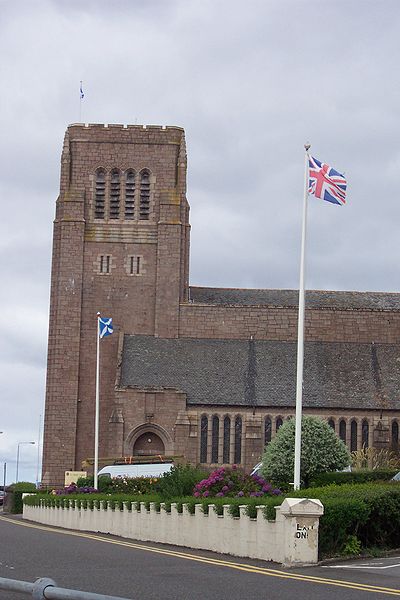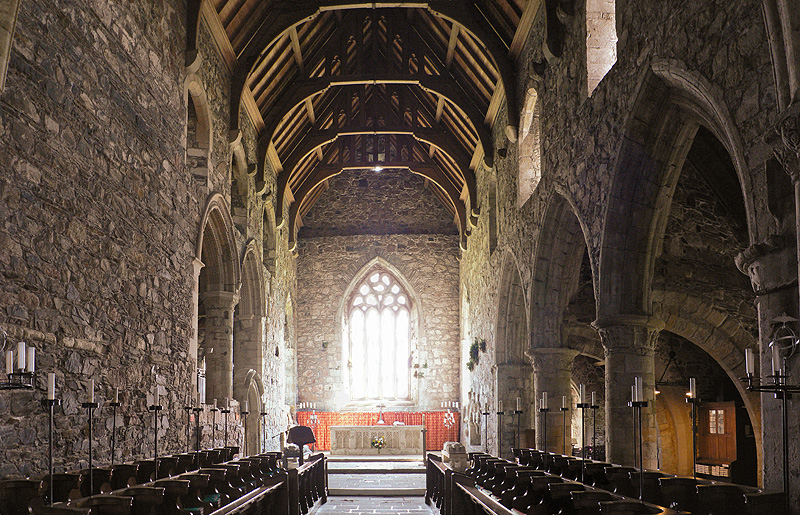St Columba's Cathedral, Oban, Scotland
The website of the Diocese of Argyll & the Isles gives some information about the cathedral with a photo giving a better idea of its beautiful location.
Last Sunday, 9 June, was the Solemnity of St Columba (Colum Cille) in the Diocese of Argyll & the Isles, in western Scotland. He is patron saint of the diocese and of the cathedral. This Irish saint, an older contemporary of that other great missionary with a similar name, St Columban or Columbanus, came to Iona, a tiny island in the Inner Hebrides, 1,450 years ago. Both saints left Ireland by boat, each with twelve companions.
St Columba was born on 7 December 521 and died on 9 June 597 while St Columbanus was born c. 540 or 543 and died on 23 November 615.
A special Mass was celebrated in St Columba's Cathedral, Oban, at 5pm, with Bishop Joseph Toal of the Diocese of Argyll & the Isles the main celebrant. Archbishop Antonio Mennini, Papal Nuncio to Great Britain, was among the bishops present, as was Bishop Michael Smith of Meath, Ireland, where Kells is located. The Book of Kells was probably begun in Iona and taken to the Abbey of Kells, which St Columba had founded c. 554.
Along with Bishop Smith were the parish priest of Kells, Fr John Byrne, and four members of the town council, from four different parties. The Meath contingent presented the Diocese of Argyll & the Isles with a copy of the Book of Kells.
Present at the Mass were the leaders of other Christian communities in the area.
The bishops and concelebrating priests, who included most of the priests of the diocese and some from other dioceses along with some Cistercian monks from Nunraw Abbey and Benedictine monks from Pluscarden Abbey, were led in procession from the place where we vested to the entrance of the Cathedral by a piper. This is something very Scottish and quite moving.
A German, Jürgen Rech , playing the Scottish bagpipes
Interior of Iona Abbey Church
The following morning, Monday, 200 of us set off for the Isle of Iona, an island with a land area of only 877 hectares, on a pilgrimage to the place where St Columba founded his most famous monastery. We took the ferry from Oban to Craignure on the Isle of Mull and then travelled by bus to Fionnphort on the west coast of the island. The last leg of the journey was a ten-minute trip by boat to Iona.
It was about a ten-minute walk to the Abbey where we gathered for Mass. The principal celebrant was the Papal Nuncio, Archbishop Antonio Mennini. As in the Cathedral the day before, the responsorial psalm was sung in Gaelic by a choir of secondary school girls from the Outer Hebrides, where Gaelic is still the main language. And, also as in the Cathedral, the gospel was proclaimed first in English by a deacon and then in Gaelic by a priest.
Many Knights and Ladies of the Holy Sepulchre were present in their uniforms.
After Mass the bishops and priests had a light lunch together while the others, who had brought packed lunches, gathered in various places in the grounds of the Abbey for a picnic. The weather was most cooperative.
Many of us later dropped by Cnoc a' Chalmain, the Catholic House of Prayer, where I made a retreat in 2002 and where I'll be from 16 to 21 July before leaving the Diocese of Argyll & the Isles. 'Cnoc a 'Chalmain' means 'The Hill of the Dove', a reference to St Columba, as 'Colum' or 'Colm' are the Irish Gaelic for 'dove' and 'Calum' the Scottish Gaelic.
As always happens on a pilgrimage, many of us made new friends. One pilgrim I spent much time with had cycled from Glasgow to Oban, a distance of about 150 kms.
It was refreshing to see so many wearing religious habits, not only during Mass in the Abbey but on the whole trip. These included Benedictine monks from Pluscarden, one of them, the former abbot, now Bishop Hugh Gilbert OSB of Aberdeen, the diocese where the monastery is located. One of the young monks was a Ghanaian. There were three Cistercian monks from Nunraw, including Abbot Mark Caira and one who had spent 50 years in Cameroon, two Redemptorists, one of them a young Tanzanian, and two Carmelite nuns who had been in the monastery in Oban before it was closed down in 2002.
So there was a good missionary dimension to our piogrimage, fitting for the celebration of a saint sometimes called 'The Apostle to the Picts', the Picts being a people who lived mainly in northern and eastern Scotland.
Iona Abbey with Mull in the background
It was about a ten-minute walk to the Abbey where we gathered for Mass. The principal celebrant was the Papal Nuncio, Archbishop Antonio Mennini. As in the Cathedral the day before, the responsorial psalm was sung in Gaelic by a choir of secondary school girls from the Outer Hebrides, where Gaelic is still the main language. And, also as in the Cathedral, the gospel was proclaimed first in English by a deacon and then in Gaelic by a priest.
Many Knights and Ladies of the Holy Sepulchre were present in their uniforms.
After Mass the bishops and priests had a light lunch together while the others, who had brought packed lunches, gathered in various places in the grounds of the Abbey for a picnic. The weather was most cooperative.
Many of us later dropped by Cnoc a' Chalmain, the Catholic House of Prayer, where I made a retreat in 2002 and where I'll be from 16 to 21 July before leaving the Diocese of Argyll & the Isles. 'Cnoc a 'Chalmain' means 'The Hill of the Dove', a reference to St Columba, as 'Colum' or 'Colm' are the Irish Gaelic for 'dove' and 'Calum' the Scottish Gaelic.
As always happens on a pilgrimage, many of us made new friends. One pilgrim I spent much time with had cycled from Glasgow to Oban, a distance of about 150 kms.
It was refreshing to see so many wearing religious habits, not only during Mass in the Abbey but on the whole trip. These included Benedictine monks from Pluscarden, one of them, the former abbot, now Bishop Hugh Gilbert OSB of Aberdeen, the diocese where the monastery is located. One of the young monks was a Ghanaian. There were three Cistercian monks from Nunraw, including Abbot Mark Caira and one who had spent 50 years in Cameroon, two Redemptorists, one of them a young Tanzanian, and two Carmelite nuns who had been in the monastery in Oban before it was closed down in 2002.
So there was a good missionary dimension to our piogrimage, fitting for the celebration of a saint sometimes called 'The Apostle to the Picts', the Picts being a people who lived mainly in northern and eastern Scotland.





No comments:
Post a Comment